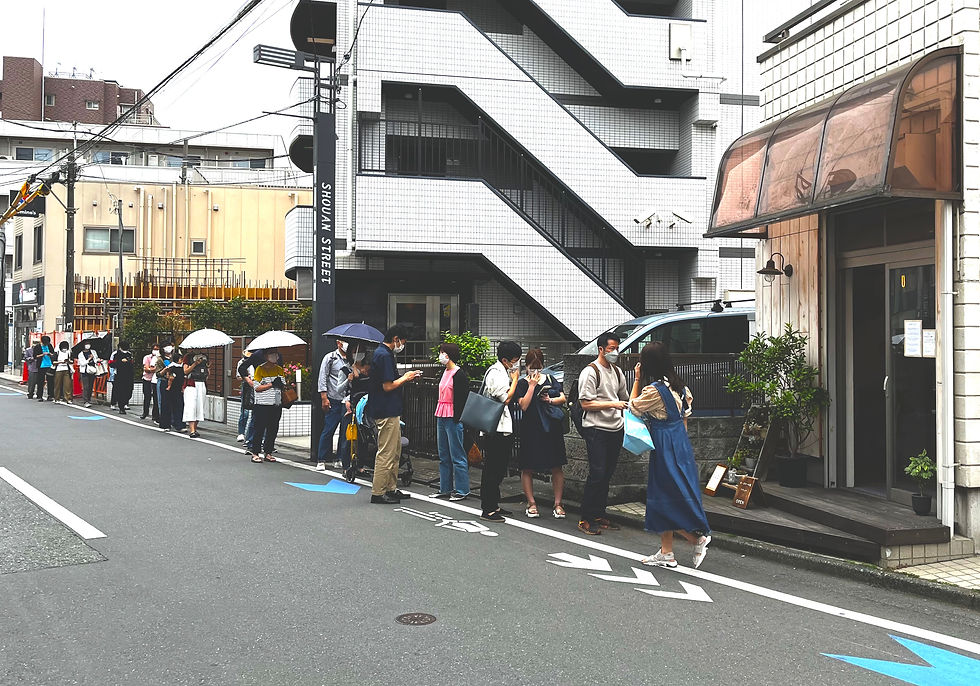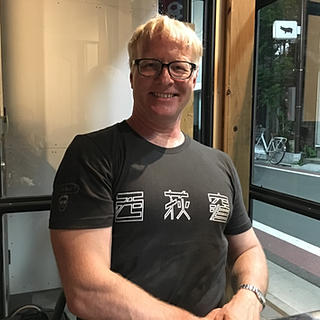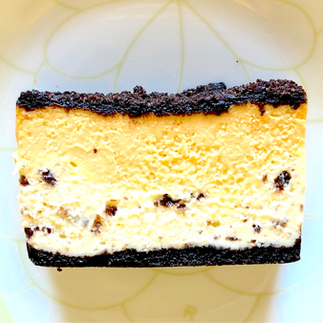How to Succeed as an F&B Microbusiness (Cheesecake)
- James Farrer
- Aug 4, 2022
- 9 min read
Updated: Dec 31, 2022

There are many very small food shops in Nishiogi that can be described as microbusinesses, with one owner-operator doing all the work in a narrow space. From both sociological and economic perspectives, it is a special type of existence. Some are what can be called “rarely open shops,” operating only a few days a week. But when they open, a queue forms immediately. How do such successful microbusinesses sustain themselves? Can they secure a stable income? How do they connect with your customers? Is it lonely working alone every day? We visited one successful microbusiness to find out.
The Cheesecake Sorashina, which opened in July 2020 in the middle of the COVID pandemic, is one such "rarely open shop.” The owner, who rents the space, manages it alone. Sales start at noon on business days. Lines have already begun to form a half hour before the store opens. And when we visited around 3 o'clock, the shop was already closed because it had sold out. Often the actual business hours are less than three hours. What about this way of doing business? How can someone survive on such short business hours? We asked the owner.

Becoming a Cheesecake Artisan
The owner and pastry chef is Iwase Ryosuke. He is from Shikoku originally, but he now lives in Nishiogi. "I've been in Tokyo since I was in high school,” Iwase said. “Then I went to a confectionery vocational school in Tokyo…. Well, now I'm 33. It's been over 10 years ago. I finished school when I was 20 years old, and then I worked at a hotel, and I entered in a cake shop. It was in Takanawa, Takanawa Prince Hotel. The next workplace was Kichijoji. I worked as a dessert specialist at a cafe in Kichijoji, so I moved to Nishi-Ogikubo at the next station…. I've always wanted to open my own shop since I was a student. I decided to do it when I was thirty. So when I thought about what to do with the place, Nishiogi, the atmosphere was amazing. Oh, I wanted to be here. I like Nishiogi instead of Kichijoji. After all, as you said earlier, there are a lot of private shops. I felt that it was a unique town, so I also thought that a cheesecake specialty store would fit in (laughs).”
Iwase told us that he has taken almost no holidays for two years since opening. We wondered what he did in the days on which the cheesecake shop is not open. Since the shop is only open roughly twice a week, what is he doing on the other days? "Simply put,” he said. “I'm always preparing for two days to make something that is on sale for one day.” One day is spent purchasing and planning and the next day baking. Of course, he explained, to open a shop by yourself, you have to do everything from shopping to preparation by yourself, which inevitably reduces the number of business days.
Of course, making it alone and selling it alone is a daunting task. Iwase planned to start out slowly, but was rewarded with an overwhelming reception from customers. "I was planning from the beginning on doing this alone,” he said. “So I didn't do any marketing ... I didn't want to be too busy, so I started without any publicity. But I feel really grateful for the results.”

The attraction was the unusual and luxurious varieties of cheesecake. Alongside a signature Basque cheesecake with cappuccino flavors his creative menu in May 2022 included items such as “Fig vanilla and cardamon,” “Zunda (edamame paste), "Black sesame and marscarpone,” “Peanut butterscotch,” and “Prune, honey and blue cheese.” We tried all of them!
Despite this initial success, he plans to continue running the place all on his own.
“Well, I'll do it as much as I can within my limits. Like this, even if the same recipe is made by different people, the taste will be different ... I hate that ... I want to do as much as I can on my own. I enjoy [working alone]. I'm not lonely at all (laughs). Rather, if there are other staff members, I'll pay attention to that person ... I can't concentrate so much on what I am doing. I enjoy just working silently. "
Basically, Iwase enjoys working on his cheesecake with no distractions from other people.
The design theme of the Sorashina store is functional minimalism and is dominated by the kitchen utensils for making cheesecake. This is a rental property, and it used to be occupied by the popular Moroccan restaurant Tam Tam. “I did it all myself,” Iwase said. “There first floor was stripped clean, so there was nothing at all. Well, then I painted this (wall) myself ... I did it. I did it all (laughs) Ah, but it took about three weeks. I also did the ceiling. (What about the counter table?) I did it myself. I didn't know what to do at first, but I got someone to teach me.”

Seeking Advice from an F&B Consultancy
Iwase saved up his money to open the shop. However, though he was sure of his goal, he wasn’t sure of his methods. He, therefore, attended a seminar by a consultancy specializing in advising F&B (food and beverage) businesses. "I attended a lot of seminars,” he said. “It covered various things about opening a business. After attending the seminars, I get a lot of free consultations. That's why, well, I was willing to try something like this with my own funds. That's why."
Because the case of Sorashina was an interesting case study for the company as well, the consultancy filmed the nine months process of opening the business and introduced it in a series of videos on YouTube (The first installment is here).
In the video, Keita Kaneko, the lead consultant, talks about Iwase’s prospects. "At first, I thought this wasn't good,” she says. “He didn't have a lot of self-financing, right? But when I stepped in and asked, he was specializing in cheesecake, the equipment was minimal, and he wasn't particular about the location." It seemed that a specialty cheesecake store might find a niche, however.
As it turned out, Sorashina cheesecake is something that customers want to buy even if they have to line up for it. We asked him about his commitment to cheesecake which created such an instant reputation. The types vary depending on the month, he said, but there are always about five types of cheesecake on offer in the store. He tries sample after sample, and only the products that he is satisfied with are put out for sale. We asked him why he made it a cheesecake specialty store. "Cheesecake was the most interesting thing to make,” he said. “I just wanted to do this. There are many combinations. There are many ways to make it. Rare cheese, soufflé, baked ... You can make different types. Just because it's cheesecake, the category is well established. I feel a little attraction there ... Also, I made cheesecake at cake shops and hotels, but I enjoyed it while I was making it ... it was overwhelmingly fun. I mean, I can do something extra ... If I put more like this, it will be more like this. That's why it appealed to me. "
"Even if I made shortcakes, I couldn't come up with any ideas beyond that. I think strawberry shortcakes are complete with that alone. Well, there are shops that fill them with fruits and melons; there are some, but I was wondering if there was so much room for growth. Cheesecake was like anything that goes well with cheese. Well, you can change the type of cheese. If it goes well with cheese, then you can put it in. So I began to think it was possible to do this. "
Although each type of cheesecake involves different recipes, there is a common base. "The base is cream cheese,” he said, “but I have used mascarpone as an accent, and I also have used Mimolette. It's French cheese. I have also used Gorgonzola. So I use different cheeses for an accent, but the base is cream cheese. "
Not only does the cheese base change for each type of cake, but so does the baking method, which is one reason for the long workdays. “It's different for each one,” explained Iwase. “For example, the method of making Basque is completely different from others. We bake it at a high temperature all at once. The surface is a little scorched, but the inside is thick and moist. Then, with fig, we use a steam bath, and it's like steaming because it's baked with boiling water. Prunes are a type that is usually baked in an oven. Strong heat is used. For each the way to make it is completely different.”
Of course, he also varies the cheese for each cake. "Basque mixes French cream cheese and Hokkaido cream cheese. French cream cheese is a little salty. It has a lot of salt. Hokkaido cream cheese is a little mellow. Fig is based on cream cheese, but it contains a lot of sour cream. It also has a bit of sourness.”
Then there are other specialty ingredients. Black sesame zunda cheesecake uses a very particular domestically produced black sesame. “It's more fragrant than imported ones. There are many from China, but the taste and fragrance are completely different.” For the peanut butterscotch cheesecake, he adds real butter.
He doesn’t think much about discussions of “authenticity” and national origins when making cheesecake. "Ah, I'm not thinking about it (laughs),” he said. “I'm just serving the cheesecake I like and want to eat. I'm not into sweetness, there are quite a lot of people like that. When I hear it, I feel like I'm doing it in a different way than usual. I'm really into sweets, and I am thinking of it more as a type of cuisine."
Iwase talks about the varieties of cheesecake with enthusiasm, and his creative offerings are likely to continue to expand.
Surviving as an F&B Microbusiness
Finally, we asked what we had been most curious about. Since he is open so few days, how is he able to survive? "Am I in the red or in the black?” Iwase asked, paraphrasing our question with a laugh. “Well, it's not in the red. I have the most income I've ever worked for!"
Although the premises are tiny, when the shop first opened, he actually planned both a take-out shop and a sit-down cafe along a narrow counter. “At first, I was about to serve it with coffee. I bought some utensils, but I couldn't afford them anymore. I don't have time to brew it anymore .... So, I changed to a take-out specialty store…. At first, the number of customers was about half of what it is now, and the number of business days was about twice as long as it is now. But, it sold out faster than I expected. As for promotion, I didn't do it at all. Other than the signboard. I haven't done anything. Except, I'm doing Instagram."
All of his sales are at the shop, he explained. There are no internet sales. He wants to be very particular about the taste of cheesecake, so he wants to avoid complications that come from plural sales channels. "When I am sold out, I am finished ... I haven't made a reservation system. Somehow, the line is full ... "
The cakes are sold piece by piece. Each piece costs between 529 and 637 yen. We calculated, and the number of cake pieces sold out once the shop is opened is about 150. At most 200. Since the average customer buys about four pieces, the number of customers is about 30 to 50 each business day. In May 2022, he was open on 10 days. That means his gross sales are on the order of one million yen a month. (Of course, his net income must subtract costs such as rent, utilities, and ingredients.)
But when we asked, we learned that his own business income isn’t just from this shop. In fact, Mr. Iwase said that he is also engaged in the cheesecake licensee business because of the strength of the unique and attractive cheesecake product. The mediator is M & A Auction Co., Ltd., which supported the opening of the business. "This was their first attempt at the licensing business,” he said. “It sounded interesting, this type of business method…. I just think up a cheesecake for the licensee and give it to them… I don’t use my name. I haven't put my name on anything."
He is given a fee for each recipe and also provides classroom instruction on baking to the chefs at the other shop. In the food and beverage industry, recipes are often distributed for free once products are released. However, his specialization in cheesecake allowed him to develop this type of licensing side business.
The customers who line up in front to buy such Sorashina cheesecake sometimes come from quite a distance, even outside Tokyo. "There were even people from Kyoto,” he said. “It seems that they came to Tokyo on business, but they chose this as one of the destinations and lined up at the top first, for cheesecake. I put a lot of ice pack. And they took it home ... I remember putting a lot of ice packs in. "

Considering COVID prevention, only one person can enter the store at a time. However, though Iwase is busy, he communicates with each customer while wrapping the cake, and the paper bag containing the cake comes out of the counter and is handed to the customer.
Finally, we asked if he wanted to continue as is, "That's right. Unless I collapse…. I don't have time to think about it much, so I'm still just seeing how it works out ... I think this style of shop will work out for me."
To make a business successful, one must develop an attractive product, formulate a strategy, develop the business, and market it. Iwase shows how this can be done in the form of a “rarely open” microbusiness by a single individual with few financial resources. However, his story also shows consultancies and licensing opportunities can now provide advice and resources for a lone operator. A new online business environment seems to be emerging for innovative small F&B entrepreneurs. (James Farrer Aug. 4, 2022)
(Interview by James Farrer and Fumiko Kimura, May 18, 2022, transcription and Japanese editing by Fumiko Kimura, translation by James Farrer, copyright by James Farrer all rights reserved)









